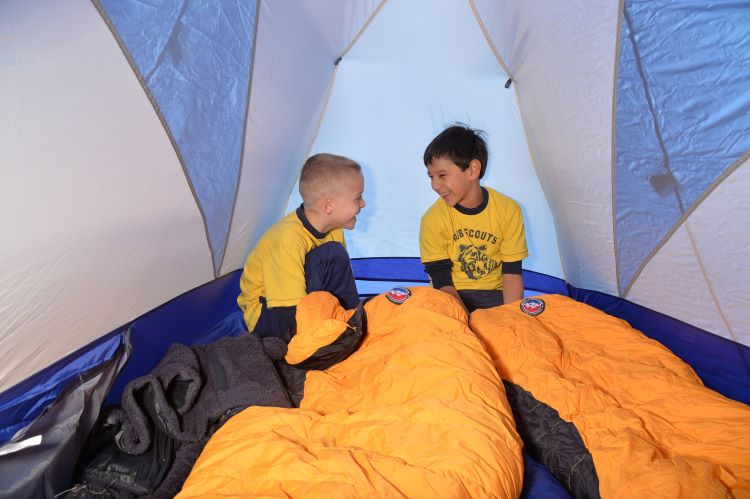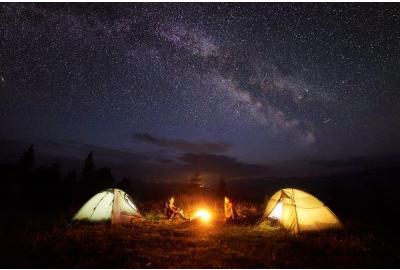5 Common Mistakes When Setting Up Your Sleep System
Learn to Sleep Comfortably Outdoors
Have you ever gone camping or backpacking and crawled into your tent for the night only to get a poor night's sleep? Whether it's back pain, sore neck, or exhaustion from tossing and turning, poor sleep can ruin the fun of an outdoor adventure—especially if you're just getting into Scouting!


We've all been there. You paid a lot of money for the best sleeping bag or sleeping pad only to wake up in the middle of the night shivering. If this is the case, then the thought of sleeping under the stars is nightmare fuel to you. But what if we told you it didn't have to be that way? For those new to Scouting who have yet to have the best experience sleeping outdoors, we've got five tips to help you solve some of the mistakes you're making when assembling your sleep system.
Why Is It So Hard to Sleep While Camping?
Sure, beds are awesome. Even before joining Lion Cub Scouts, we enjoyed the comfort of being tucked into a soft, warm bed every night. The truth is that when you're used to something so comfortable, it can be hard to get accustomed to anything else. But the thing is—nothing beats the beauty of sleeping under the stars. Some studies have even shown that spending time away from the screens and in nature helps us decrease stress, recharge, and relax.
Sleeping in the great outdoors can still have its downsides. The ground can be cold, hard, and uneven. Strange noises can keep us up at night. The stars can be a little too bright for our liking, or we're just too used to our bed. Whatever the reason, if you're new to overnight campouts, you're bound to run into a problem or two. Thankfully, there is a solution for everything, and Scouts are always prepared. If you're a new Scout or parent gearing up for your first night under the stars, read on to learn more about the mistakes you can make building your sleep system.
5 Mistakes Every New Scout Makes with their Sleep System
- You don't understand the rating system of sleeping pads
- Your sleeping bag is the wrong size
- You're packing the wrong sleeping bag for the season
- Your pad is too narrow
- You're not using a camping pillow
1. Understand the Rating System of Sleeping Pads
Your sleeping pad is half the warmth of your entire sleep system. Yes, a pad provides an extra layer of cushion between you and the cold, hard ground, but it's also designed to compensate for the lack of heat retention. Sadly, it doesn't matter if your sleeping bag has a temperature rating of 0°F—when you're lying inside your bag, the insulation compresses underneath you, leading to heat loss. You're relying on the sleeping pad to keep your underside warm, and if the pad you're using doesn't have the correct temperature rating (especially when winter camping), you can end up freezing in the middle of the night. That's why it's essential to understand the R-rating system of your sleeping pad. The R-value measures a pad's capacity to resist heat flow, hence the "R." The higher the pad's R-value, the better it will insulate you from the cold. Sleeping pad R-values range from less than 2 (minimum insulation) to 5 or more (max insulation). The higher the number, the more insulation the sleeping pad provides. We recommend a sleeping pad with an R-value of 4 or more for winter camping. The Klymit Insulated Static V Pad features an R-value of 4.4, can be inflated in as little as 10-15 breaths, and was designed with dynamic side rails to cradle you comfortably for a more restful sleep in any camping condition.


2. Find the Perfect Sleeping Bag for You
The season is essential when choosing the right sleeping bag, and you should start with the shape of your bag. The two main shapes for sleeping bags are mummy and rectangular, although different brands have some of their unique shapes. The goal of a sleeping bag is to trap your body heat to keep you warm. So, the colder the climate, the slimmer fit you should aim for with shape. Rectangular sleeping bags are great for summer, while mummy sleeping bags are ideal for winter. Winter sleeping bags tend to be more narrow and constrictive for heat retention, which is excellent for cold-weather camping and not so great if you are taller or toss and turn a lot in your sleep. If you want a more in-depth look at choosing the right sleeping bag, check out The Scout's Guide to Sleeping Bags. For taller Scouts on a winter campout, we recommend the Scouting America 20°F Mummy Sleeping Bag. It's the perfect bag for temps that fall between 35°F-40°F. It also comfortably fits anyone up to 6'2" tall and has an adjustable foot box to size it up or down as needed, so the bag can "grow" with the Scout.


3. Choose the Right Bag for the Weather
Waking up shivering is a terrible experience that can ruin all your camping fun. To avoid being cold at night, one key factor you should understand is the temperature rating of your sleeping bag. If you check the weather forecast and get an idea of the temperatures you can expect on your next campout, you can choose the right bag to keep you warm below those temperatures. For example, if the high on your overnight campout is expected to be 40°F, you want a sleeping bag with a temp rating of 20°F or below. This is crucial in building a sleeping system that will keep you warm and toasty on an overnight camping trip. Now, not every sleeping bag comes with an accurate temperature rating printed on the bag. Sometimes a manufacturer will list the comfort, transition, or risk range. You should look for the EN or "European Norm" rating. The EN rating is the standardized method for rating the warmth of sleeping bags and is one of the most accurate ways to ensure that the sleeping bag you choose will keep you warm at night. For cold-weather adventures, we recommend the Klymit KSB 20°F Mummy Sleeping Bag. This sleeping bag is ideal for temperatures between 35°F-40°F but won't keep you warm if temps fall below 20°F. The bag's 650-fill power duck down delivers exceptional warmth for its weight, and the baffles hug you tight but stretch out to allow for movement.


4. Select a Pad that Isn't Too Narrow
There are a lot of sleeping pads out there, but most of the ones you'll find are 20 inches wide. That's like six crayons stacked horizontally. Yeah, pretty narrow—if you're a parent! The thing is that most seasoned backpackers are used to more narrow sleeping pads because they take up less space inside a pack. But if you're new to Scouting, it's going to be tough staying on the pad. If you don't want to wake up shivering on the ground, we recommend the 37N XL Sleeping Pad. This is an extra-wide sleeping pad with curved baffles designed to cradle your body as you sleep. The pad weighs a little over two pounds, so it's not ideal for backpackers, but it will help you get a good night's sleep if you're a parent who wants to go on more overnight campouts with your Scout.


5. Pack a Good Camping Pillow
It can be easy to overlook a camping pillow when gearing up for an overnight camping trip in the great outdoors. But as any sleep expert will tell you, a good night's rest starts with a great pillow. Camping pillows aren't designed to compete with the memory foam pillows advertised by some of the largest pillow manufacturers in the world. However, a great camping pillow can help prevent a sore neck and help you feel energized and refreshed before a hike. We recommend the Klymit Luxe Inflatable Pillow to help you get great sleep outdoors. This lightweight camping pillow features durable polyester construction and is machine washable. It also features a quilted, soft-touch "pillowcase" that is both lightweight and comfortable. Whether you need it for an overnight campout or want something to take with you on long road trips, this is one of the best inflatable pillows for the price. Want a more in-depth look at Klymit Pillows at Scout Shop? Check out the video below!


Build the Perfect Sleep System at Scout Shop
Whether you've been on a campout or two or are gearing up for your first overnight camping adventure, we hope these tips help you get a good night's sleep. For sleeping bags and pads, inflatable pillows, sleeping bag liners, and more sleep system gear visit ScoutShop.org—the official online retail store of the Scouting America!




















